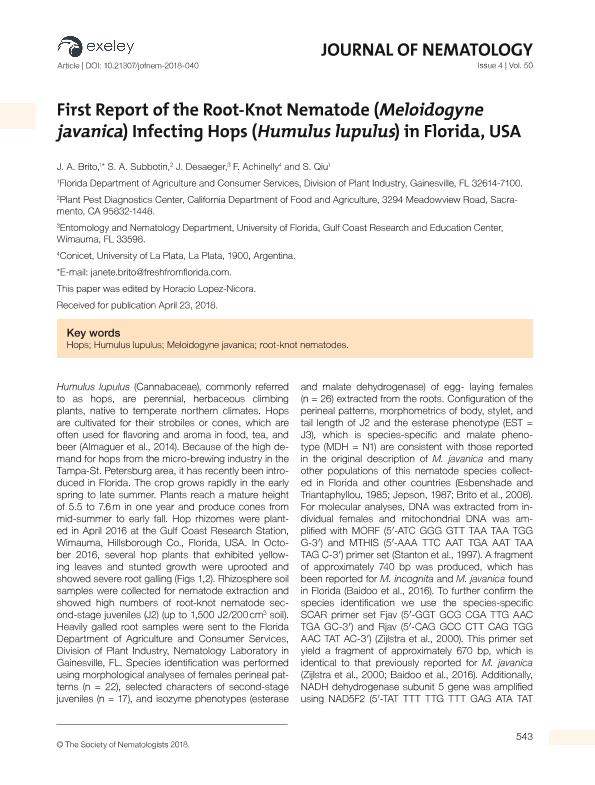Mostrar el registro sencillo del ítem
dc.contributor.author
Brito, J. A.
dc.contributor.author
Subotini, S.A.
dc.contributor.author
Desaeger, J.
dc.contributor.author
Achinelly, Maria Fernanda

dc.contributor.author
Qiu, Sai
dc.date.available
2019-10-21T18:43:15Z
dc.date.issued
2018-12
dc.identifier.citation
Brito, J. A.; Subotini, S.A.; Desaeger, J.; Achinelly, Maria Fernanda; Qiu, Sai; First Report of the Root-Knot Nematode (Meloidogyne javanica) Infecting Hops (Humulus lupulus) in Florida, USA; Soc Nematologists; Journal Of Nematology; 50; 4; 12-2018; 343-344
dc.identifier.issn
0022-300X
dc.identifier.uri
http://hdl.handle.net/11336/86700
dc.description.abstract
Humulus lupulus (Cannabaceae), commonly referred to as hops, are perennial, herbaceous climbing plants, native to temperate northern climates. Hops are cultivated for their strobiles or cones, which are often used for flavoring and aroma in food, tea, and beer (Almaguer et al. 2014; Burgess 1964). Because of the high demand for hops from the micro-brewing industry in the Tampa-St. Petersburg area, it has recently been introduced in Florida. The crop grows rapidly in the early spring to late summer. Plants reach a mature height of 18-25 feet in one year and produce cones from mid-summer to early fall (Pearson, 2016). Hop rhizomes were planted in April 2016 at the Gulf Coast Research Station, Wimauma, Hillsborough Co., Florida, USA. In October 2016, several hop plants that exhibited yellowing leaves and stunted growth were uprooted and showed severe root galling (Figs.1;2). Rhizosphere soil samples were collected for nematode extraction and showed high numbers of root-knot nematode second-stage juveniles (J2) (up to 1500 J2/ 200cm3 soil). Heavily galled root samples were sent to the Florida Department of Agriculture and Consumer Services, Division of Plant Industry Nematology Laboratory in Gainesville, FL. Species identification was performed using morphological analyses of females perenal patterns (n=22), selected characters of second-stage juveniles (n=17), and isozyme phenotypes (esterase and malate dehydrogenase) of egg- laying females (n=26) extracted from the roots. Configuration of the perineal patterns, morphometrics of body, stylet and tail length of J2 and the esterase phenotype (EST= J3), which is species-specific and malate phenotype (MDH=N1), are consistente with those reported in the original descrition of M. javanica and many other populations of this nematode species collected in Florida and other countries (Brito et al., 2008; Cofcewick et al., 2005; Carneiro et al., 2004; Jepson, 1987; Esbenshade and Triantaphyllou, 1985). For molecular analyses, DNA was extracted from individual females and mitochondrial DNA was amplified with MORF (5?- ATC GGG GTT TAA TAA TGG G - 3?) and MTHIS (5? - AAA TTC AAT TGA AAT TAA TAG C -3?) primer set (Pagan et al., 2015; Stanton et al., 1997). A fragment of approximately 740 bp was produced, which has been reported for M. incognita and M. javanica found in Florida (Baidoo et al., 2016). To further confirm the species identification we use the speices-specific SCAR primer set Fjav (5 ?- GGT GCG CGA TTG AAC TGA GC - 3?) and Rjav (5? - CAG GCC CTT CAG TGG AAC TAT AC - 3?) (Zijlstra et al., 2000). This primer set yield a fragment of of approximately 670bp, which is identical to that previously reported for M. javanica (Humphreys-Pereira et al., 2017; Baidoo et al., 2016; Zijlstra et al., 2000). Additionally, NADH dehydrogenase subunit 5 gene was amplified using NAD5F2 (5?- TAT TTT TTG TTT GAG ATA TAT TAG - 3?) and NAD5R1 (5?- CGTGAATCTTGATTTTCCATTTTT-3?) primers as described by Janssen et al. (2016). The GenBank accession number of the nad5 gene sequence is MH230176. The obtained the nad5 gene sequence was identical to the reference sequence of M. javanica provided by Janssen et al. (2016). To our knowledge, this is the first report of H. lupulus as a host of the Javanese root-knot nematode (M. javanica) in Florida.
dc.format
application/pdf
dc.language.iso
eng
dc.publisher
Soc Nematologists

dc.rights
info:eu-repo/semantics/openAccess
dc.rights.uri
https://creativecommons.org/licenses/by-nc-sa/2.5/ar/
dc.subject
FIRST REPORT
dc.subject
MELOIDOGYNE JAVANICA
dc.subject
HUMULUS LUPULUS
dc.subject
FLORIDA
dc.subject.classification
Otras Ciencias Agrícolas

dc.subject.classification
Otras Ciencias Agrícolas

dc.subject.classification
CIENCIAS AGRÍCOLAS

dc.title
First Report of the Root-Knot Nematode (Meloidogyne javanica) Infecting Hops (Humulus lupulus) in Florida, USA
dc.type
info:eu-repo/semantics/article
dc.type
info:ar-repo/semantics/artículo
dc.type
info:eu-repo/semantics/publishedVersion
dc.date.updated
2019-10-17T14:07:45Z
dc.journal.volume
50
dc.journal.number
4
dc.journal.pagination
343-344
dc.journal.pais
Estados Unidos

dc.description.fil
Fil: Brito, J. A.. University of Florida; Estados Unidos
dc.description.fil
Fil: Subotini, S.A.. University of California; Estados Unidos
dc.description.fil
Fil: Desaeger, J.. University of Florida; Estados Unidos
dc.description.fil
Fil: Achinelly, Maria Fernanda. Consejo Nacional de Investigaciones Científicas y Técnicas. Centro Científico Tecnológico Conicet - La Plata. Centro de Estudios Parasitológicos y de Vectores. Universidad Nacional de La Plata. Facultad de Ciencias Naturales y Museo. Centro de Estudios Parasitológicos y de Vectores; Argentina
dc.description.fil
Fil: Qiu, Sai. University of Florida; Estados Unidos
dc.journal.title
Journal Of Nematology

dc.relation.alternativeid
info:eu-repo/semantics/altIdentifier/doi/http://dx.doi.org/10.21307/jofnem-2018-040
dc.relation.alternativeid
info:eu-repo/semantics/altIdentifier/url/https://www.exeley.com/journal_of_nematology/doi/10.21307/jofnem-2018-040
Archivos asociados
